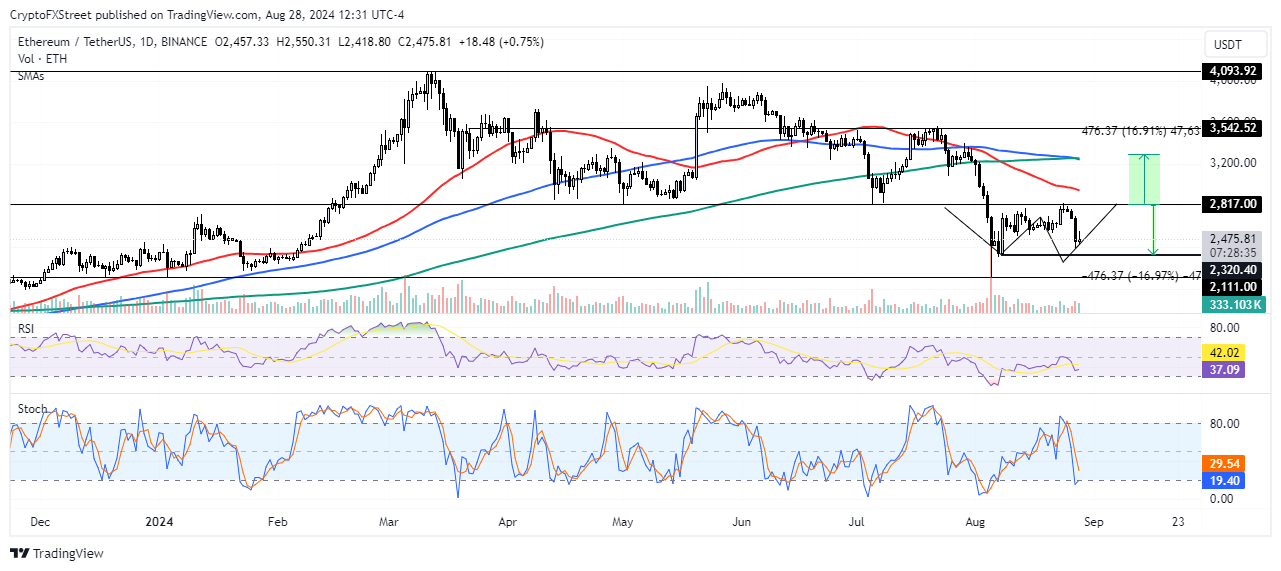- Ethereum’s declining open interest suggests traders are becoming extra cautious.
- Spot traders may be buying the dip following growing ETH exchange net outflows.
- Weak demand for Ethereum ETFs has pushed asset managers to consider filing for combined spot ETH and BTC ETFs.
- Ethereum could rally by 30% if double bottom move holds.
Ethereum (ETH) is down over 2% on Wednesday as spot traders are potentially pouncing on the recent market decline to buy the dip. Meanwhile, the top altcoin has formed a double bottom on the daily chart, indicating potential for a 30% rally.
Daily digest market movers: ETH OI, Exchange outflows, weak Ethereum ETFs
Following ETH’s 9% plunge on Tuesday, Ethereum open interest briefly declined by almost $1 billion to $10.42 billion before recovering slightly. Open interest (OI) is the total number of outstanding derivatives positions in an asset’s market. A decline in OI indicates that traders are either liquidating or closing their positions. In the case of Ethereum, the drop in OI suggests traders are becoming extra cautious.
On the other hand, spot traders appear to be buying the dip, considering that the ETH exchange netflow flipped to net outflows of 65.2K ETH in the early hours of the American session, per CryptoQuant’s data. Exchange netflow is the difference between coins flowing in/out of exchanges. Outflows suggest buying pressure is dominant, while vice versa for inflows. If the buying pressure sustains, ETH could see a correction to previous highs.
%20-%20All%20Exchanges%20(2)-638604679950927288.png)
ETH Exchange Netflow
On the ETF front, Ethereum ETFs stretched their streak to nine consecutive days of negative flows after posting net outflows of $3.4 million on Tuesday. Despite ETH’s price decline, Fidelity’s FETH and Bitwise’s ETHW managed net inflows of $3.9 million and $1.9 million, respectively. However, $9.2 million in outflows from Grayscale’s ETHE flipped the total net flows figure negative. Unlike crypto exchanges, outflows in ETFs suggest dominant selling pressure and vice versa for inflows.
The increasing outflows have brought ETH ETFs’ net flows in the first five weeks after launch close to $500 million. In comparison, Bitcoin ETFs saw over $5 billion in net inflows within their first five weeks.
According to JP Morgan analysts, the weak flows of ETH ETFs compared to Bitcoin ETFs were expected due to the absence of staking and lower liquidity. The analysts noted that Grayscale ETHE outflows exceeded their ~$1 billion expectations. The weak demand for ETH ETFs has led asset managers to consider a combined spot BTC and ETH ETF.
“Due to weaker demand for spot ether ETFs compared to bitcoin, there appears to be a growing interest among asset managers to file for a combined ETF that offers exposure to bitcoin and ether,” noted JP Morgan analysts.
ETH technical analysis: Ethereum could stage 30% rally
Ethereum is trading around $2,510 on Wednesday, down more than 2% on the day. In the past 24 hours, ETH has seen $85.45 million in liquidations, with long and short liquidations accounting for $67.29 million and $18.16 million, respectively.
Ethereum is forming a W pattern or double bottom on the daily chart after posting two key price bottoms on August 8 and 27. When it occurs during a downtrend, the double bottom is considered a potential bullish reversal. ETH has to rally above the neckline resistance at $2,817 to validate the pattern however.

ETH/USDT Daily chart
A successful completion of this move could see ETH rise by over 30% to the $3,300 psychological level. However, the 100-day and 200-day Simple Moving Averages (SMA) could stand as resistance on the way up. Failure to move above the $2,817 resistance could send ETH toward the support level around $2,320.
The Relative Strength Index (RSI) suggests that bearish momentum is prevailing, as it is trending toward the downside after breaching its moving average on Monday.
The %K line of the Stochastic Oscillator (Stoch) crossed into the oversold region on Tuesday and is at 17 at the time of writing. If the %K line manages to cross above its descending %D line in the oversold region, it could signal a bullish reversal.
Ethereum FAQs
Ethereum is a decentralized open-source blockchain with smart contracts functionality. Serving as the basal network for the Ether (ETH) cryptocurrency, it is the second largest crypto and largest altcoin by market capitalization. The Ethereum network is tailored for scalability, programmability, security, and decentralization, attributes that make it popular among developers.
Ethereum uses decentralized blockchain technology, where developers can build and deploy applications that are independent of the central authority. To make this easier, the network has a programming language in place, which helps users create self-executing smart contracts. A smart contract is basically a code that can be verified and allows inter-user transactions.
Staking is a process where investors grow their portfolios by locking their assets for a specified duration instead of selling them. It is used by most blockchains, especially the ones that employ Proof-of-Stake (PoS) mechanism, with users earning rewards as an incentive for committing their tokens. For most long-term cryptocurrency holders, staking is a strategy to make passive income from your assets, putting them to work in exchange for reward generation.
Ethereum transitioned from a Proof-of-Work (PoW) to a Proof-of-Stake (PoS) mechanism in an event christened “The Merge.” The transformation came as the network wanted to achieve more security, cut down on energy consumption by 99.95%, and execute new scaling solutions with a possible threshold of 100,000 transactions per second. With PoS, there are less entry barriers for miners considering the reduced energy demands.

























